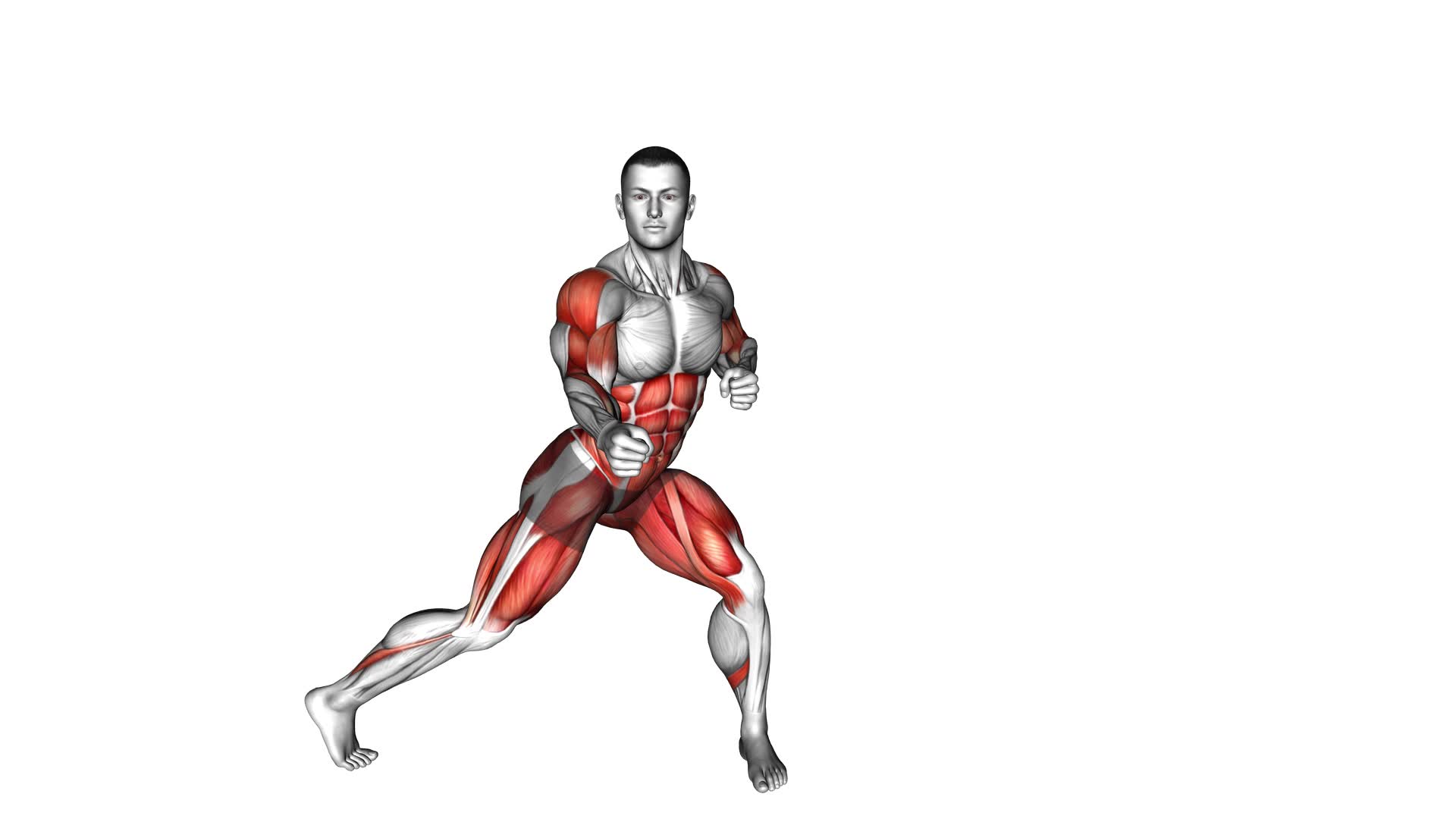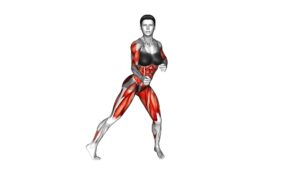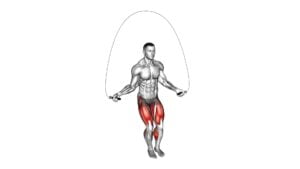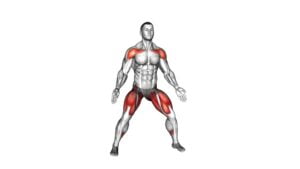Rope Pull Side Step (male) – Video Exercise Guide & Tips

Get ready to take your workout to the next level with the Rope Pull Side Step. This dynamic exercise targets your entire body, building strength, endurance, and coordination.
Watch This Exercise Video
In this video exercise guide, you'll learn the proper form and technique, as well as variations and modifications to suit your fitness level. Avoid common mistakes and maximize your results with helpful tips.
Get ready to challenge yourself and achieve your fitness goals with the Rope Pull Side Step.
Key Takeaways
- Rope Pull Side Step engages hip abductor muscles and targets glutes and outer thighs.
- The exercise requires upper body strength and coordination.
- Variations and modifications can be made to suit different fitness levels and add challenge.
- Proper technique, controlled movements, and seeking professional advice are crucial for maximizing effectiveness and reducing the risk of injury.
Benefits of Rope Pull Side Step
Experience the numerous benefits of the Rope Pull Side Step exercise. Incorporating side steps into your workouts can provide a range of advantages for your fitness journey.
Firstly, the side step motion engages your hip abductor muscles, which are crucial for stabilizing your pelvis and preventing injuries. This exercise also targets your glutes and outer thighs, helping to tone and strengthen these areas. Additionally, the rope pull aspect of the exercise requires upper body strength and coordination, making it an excellent full-body workout.
Furthermore, the Rope Pull Side Step exercise can be progressed to suit your fitness level. If you're just starting out, you can begin with a lighter resistance and focus on mastering the correct form. As you become more comfortable, you can gradually increase the resistance or try using a heavier rope.
To progress further, you can also incorporate variations into your routine. For example, you can increase the speed of your side steps or add a squat before each pull to challenge your lower body even more.
Incorporating the Rope Pull Side Step exercise into your workouts can offer a wide range of benefits, from strengthening your lower body to improving overall coordination. So why not give it a try and experience the positive effects for yourself?
Equipment Needed for Rope Pull Side Step
To effectively perform the Rope Pull Side Step exercise, there are a few essential pieces of equipment you'll need. These include a sturdy rope attachment, such as a cable machine or resistance band, and a comfortable pair of athletic shoes with good traction.
Using proper equipment not only ensures safety and stability during the exercise, but it also allows you to maximize the benefits of this dynamic movement.
Additionally, if you don't have access to traditional equipment, there are alternative options available, such as using a towel or even a heavy object as a makeshift rope.
Essential Equipment for Side Step
To properly perform the Rope Pull Side Step exercise, you'll need the following essential equipment.
First and foremost, you'll need a sturdy and reliable rope. Look for ropes that are specifically designed for strength training and have a good grip. Some of the best brands to consider are TRX, Rogue Fitness, and Lifeline.
Additionally, you'll need a solid anchor point to attach the rope. This can be a sturdy pole, a weight rack, or even a tree branch, as long as it can safely support your weight.
Lastly, it's recommended to wear comfortable athletic shoes that provide good traction and support.
With the right equipment, you can maximize the effectiveness and safety of your Rope Pull Side Step workout.
Benefits of Using Equipment
You can enhance the effectiveness and safety of your Rope Pull Side Step workout by utilizing the necessary equipment.
Using equipment such as a rope and a stable anchor point provides several advantages.
Firstly, the rope allows you to add resistance to your side step movements, making them more challenging and increasing the effectiveness of the exercise. This can help improve your strength and endurance.
Secondly, having a stable anchor point ensures that the rope remains secure during the workout, reducing the risk of accidents or injuries.
By using equipment, you can target specific muscle groups more effectively and achieve better overall results.
Alternatives to Traditional Equipment
If you don't have access to traditional equipment, there are alternative options you can use for the Rope Pull Side Step exercise.
One option is to perform bodyweight exercises that target similar muscle groups. For example, you can do lateral lunges to work your legs and glutes, or side plank exercises to engage your core and obliques. These exercises can be done at home without any equipment, making them great choices for a home workout.
Another alternative is to use household items as makeshift equipment. You can use a towel or resistance bands to mimic the pulling motion of the rope. By being creative and resourceful, you can still achieve a challenging workout without traditional equipment.
Now, let's dive into the proper form and technique for the rope pull side step exercise.
Proper Form and Technique for Rope Pull Side Step
Achieve proper form and technique for the rope pull side step by maintaining a stable stance and engaging your core throughout the exercise. This will help you avoid common mistakes and maximize the results of your training.
To start, stand with your feet shoulder-width apart and slightly bend your knees. Hold onto the rope with both hands, keeping your arms extended in front of you. As you pull the rope, step to the side with one foot, keeping your weight evenly distributed. Then, bring your other foot back to the starting position. Ensure that your movements are controlled and deliberate, focusing on using your leg muscles to generate power.
Throughout the exercise, remember to keep your core engaged by pulling your belly button towards your spine. This will help stabilize your body and prevent any unnecessary strain on your lower back. By maintaining proper form and technique, you'll be able to effectively target your muscles and improve your strength and endurance.
Transitioning into the next section, let's explore some variations and modifications for the rope pull side step.
Variations and Modifications for Rope Pull Side Step
To add variety and challenge to your rope pull side step, consider incorporating different grips and resistance levels. Here are some variations and modifications you can try:
- Grip variations: Instead of using a regular grip, try using an underhand grip or an overhand grip. This will engage different muscles in your arms and back, providing a different challenge to your workout.
- Resistance level modifications: If you want to increase the intensity of your rope pull side step, you can use a heavier resistance band or increase the weight on the cable machine. On the other hand, if you want to focus on perfecting your form or if you're just starting out, you can decrease the resistance level.
- Tempo variations: Another way to modify the rope pull side step is by changing the tempo of your movements. You can try performing the exercise at a slower tempo, focusing on the eccentric phase (when you're letting the rope back in), or you can try performing the exercise at a faster tempo to increase the cardiovascular challenge.
Common Mistakes to Avoid During Rope Pull Side Step
To ensure proper form and maximize effectiveness, it's important to frequently check for common mistakes while performing the rope pull side step. By avoiding these common mistakes, you can ensure that you're getting the most out of your workout and reducing the risk of injury.
One common mistake to avoid is letting your shoulders hunch forward. This can put unnecessary strain on your upper body and compromise your form. Instead, focus on keeping your shoulders back and down, with your chest lifted and your core engaged.
Another mistake is using too much momentum. While it may be tempting to use your body's momentum to complete the exercise, this can take away from the targeted muscle engagement and reduce the effectiveness of the movement. Instead, focus on using controlled and deliberate movements, engaging the muscles in your legs and core to perform the side step.
Lastly, make sure to maintain proper alignment throughout the exercise. Avoid leaning too far forward or backward, as this can put strain on your lower back and increase the risk of injury. Keep your spine neutral and your body centered as you perform the side step.
Tips for Maximizing Your Results With Rope Pull Side Step
To maximize your results with the rope pull side step, focus on proper technique and engage your muscles by using controlled and deliberate movements. Here are some tips to help you make the most out of this exercise:
- Maximize intensity: Increase the intensity of your rope pull side step by incorporating resistance. You can attach a resistance band to the rope handle or use a heavier rope to challenge your muscles even more. This will help to build strength and endurance in your upper body and core.
- Maintain proper form: Pay attention to your posture throughout the exercise. Keep your back straight, chest up, and shoulders back and down. Engage your core and glutes to stabilize your body. This will ensure that you're targeting the right muscles and reducing the risk of injury.
- Control your movements: Avoid rushing through the exercise. Instead, focus on performing each rep with control and precision. Slowly pull the rope towards you while stepping to the side, and then return to the starting position in a controlled manner. This will engage your muscles more effectively and maximize the benefits of the exercise.
By following these tips and incorporating resistance, you can maximize the intensity of your rope pull side step and achieve better results in terms of strength, endurance, and overall fitness.
Remember to always listen to your body and consult with a fitness professional if you have any concerns or questions.
Frequently Asked Questions
How Many Calories Can I Burn by Doing the Rope Pull Side Step Exercise?
You can burn a significant amount of calories by doing the rope pull side step exercise. This exercise is great for cardiovascular health as it gets your heart rate up and works multiple muscle groups.
Incorporating the rope pull side step into your weight loss regimen can help you burn even more calories and achieve your goals faster. It's a challenging and effective exercise that can contribute to your overall fitness and weight loss journey.
Can Rope Pull Side Step Help Improve My Balance and Coordination?
Improving your balance and coordination can have numerous benefits for your overall fitness and daily activities. Incorporating exercises like the rope pull side step into your routine can help you achieve this.
Are There Any Specific Muscles That Rope Pull Side Step Targets?
Rope pull side step is a great exercise for targeting specific muscles in your body. Without the context of the exercise guide and tips, it's important to note that rope pull side step variations can work various muscle groups such as your core, legs, and upper body.
This exercise helps to improve your balance and coordination, making it beneficial for athletes who rely on these skills for their sport.
Can Rope Pull Side Step Be Modified for Beginners or Those With Limited Mobility?
Yes, the rope pull side step exercise can be modified for beginners or those with limited mobility. There are modified variations that can be done to make it more accessible.
You don't need any special equipment to perform this exercise, just a rope and enough space to side step. By adjusting the intensity and range of motion, you can make it suitable for your fitness level and capabilities.
How Often Should I Incorporate Rope Pull Side Step Into My Workout Routine for Optimal Results?
To incorporate rope pull side step into your HIIT routine for optimal results, aim to do it two to three times a week. This exercise offers a great combination of cardiovascular and upper body engagement.
Conclusion
In conclusion, the Rope Pull Side Step is a highly effective exercise that offers numerous benefits, such as improving strength, coordination, and cardiovascular fitness.
By using the proper form and technique, along with variations and modifications, you can maximize your results and avoid common mistakes.
Remember to use the necessary equipment and follow the tips provided to ensure a safe and successful workout.
Incorporating the Rope Pull Side Step into your fitness routine can help you achieve your fitness goals efficiently.

Author
Years ago, the spark of my life’s passion ignited in my mind the moment I stepped into the local gym for the first time. The inaugural bead of perspiration, the initial endeavor, the very first surge of endorphins, and a sense of pride that washed over me post-workout marked the beginning of my deep-seated interest in strength sports, fitness, and sports nutrition. This very curiosity blossomed rapidly into a profound fascination, propelling me to earn a Master’s degree in Physical Education from the Academy of Physical Education in Krakow, followed by a Sports Manager diploma from the Jagiellonian University. My journey of growth led me to gain more specialized qualifications, such as being a certified personal trainer with a focus on sports dietetics, a lifeguard, and an instructor for wellness and corrective gymnastics. Theoretical knowledge paired seamlessly with practical experience, reinforcing my belief that the transformation of individuals under my guidance was also a reflection of my personal growth. This belief holds true even today. Each day, I strive to push the boundaries and explore new realms. These realms gently elevate me to greater heights. The unique combination of passion for my field and the continuous quest for growth fuels my drive to break new ground.







